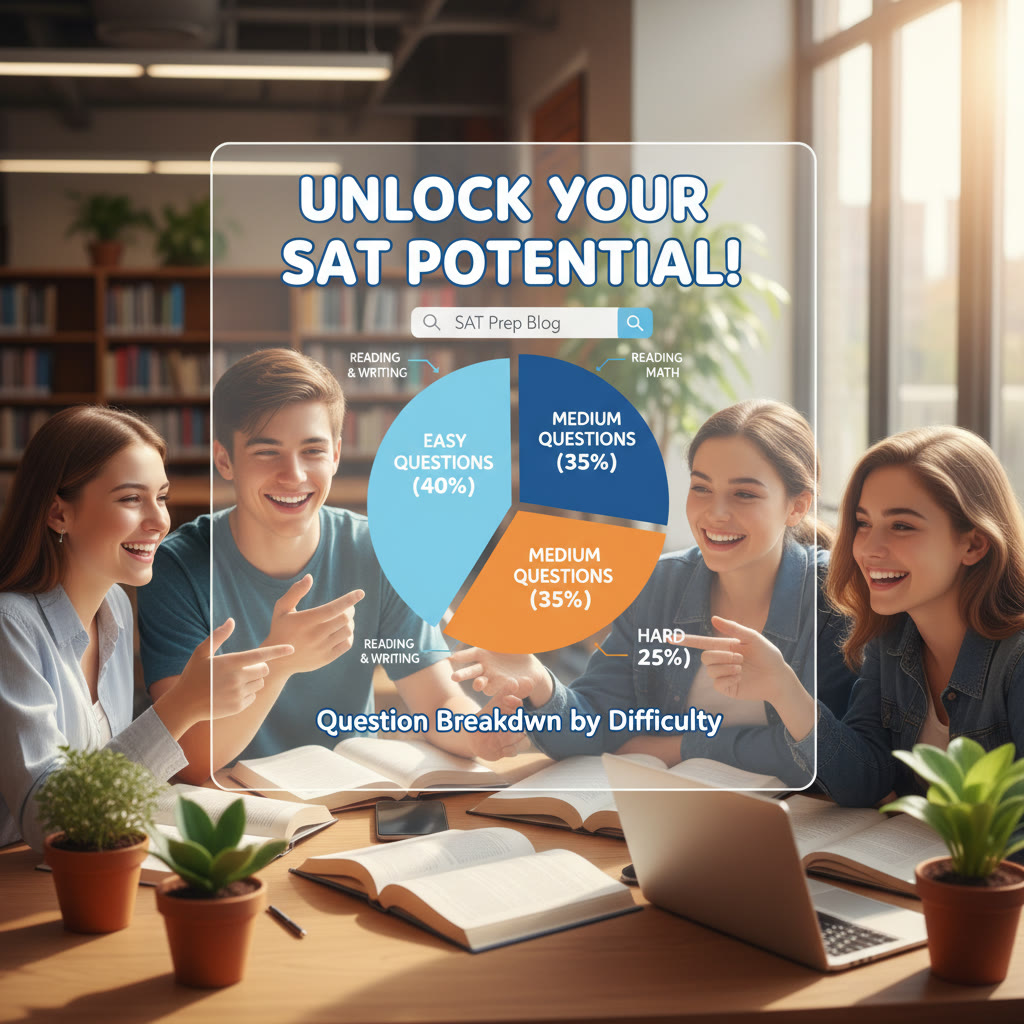The Balance Between Easy, Medium, and Hard Questions in the SAT
Take a deep breath. You’re about to step into a test that has a clever balance: some questions are straightforward, some are comfortably challenging, and a few are designed to make you think hard. Knowing how these categories are spread across the SAT — and how to handle each type — is one of the most reliable ways to raise your score without turning test prep into a full-time job.
Why question difficulty balance matters more than you think
Most students focus on learning content — vocabulary, grammar rules, formulas — and that’s essential. But the SAT is also a game of allocation: time, attention, and energy. The mix of easy, medium, and hard questions determines where you should invest your effort during the test and in your study plan. If you spend hours trying to master rare, ultra-hard question types while ignoring quick-point-easy questions, your score may not improve as much as you expect.
Think about it like running a relay. Easy questions are the steady sprinters that reliably deliver points. Medium questions demand focus and method. Hard questions are the marathoners — they can swing your score, but only if you’ve trained specifically for them.

How the SAT is structured (quick, accurate facts)
Before we dig into strategies for each difficulty level, let’s anchor ourselves in the test’s architecture:
- Reading: 65 minutes, 52 questions
- Writing & Language: 35 minutes, 44 questions
- Math No Calculator: 25 minutes, 20 questions
- Math Calculator: 55 minutes, 38 questions
- Total time (testing only): 180 minutes (3 hours)
- Score range: 400–1600 (Evidence-Based Reading & Writing combined 200–800, Math 200–800)
There’s no penalty for guessing on the SAT. That simple fact affects how you approach easy vs. hard questions: unanswered questions are always worse than educated guesses.
Approximate distribution by difficulty (realistic, practical view)
Official tests don’t publish a precise public map of question difficulty for every form, but experienced test-takers and educators observe a consistent pattern: each section typically contains a mix of easy, medium, and hard items. Below is a realistic, approximate distribution you can use for planning (numbers add to the section totals):
| Section | Questions | Easy (approx.) | Medium (approx.) | Hard (approx.) |
|---|---|---|---|---|
| Reading | 52 | 18 | 24 | 10 |
| Writing & Language | 44 | 15 | 20 | 9 |
| Math No Calculator | 20 | 6 | 10 | 4 |
| Math Calculator | 38 | 12 | 20 | 6 |
| Total | 154 | 51 | 74 | 29 |
Note: These numbers are approximate and meant to guide practice and strategy. Some official tests may lean a bit easier or harder; what’s consistent is that roughly one-third of the questions tend to be relatively accessible, about half are medium-difficulty, and a meaningful minority are tough.
What “easy,” “medium,” and “hard” really mean on the SAT
- Easy: Requires straightforward knowledge, one or two-step reasoning, or direct retrieval of facts from a passage or equation. These are the quick points.
- Medium: Requires multiple steps, combining concepts, or careful reading. These reward method and practice.
- Hard: Requires deep reasoning, uncommon combinations of skills, or tricky reading prompts. These are time-consuming and often designed to differentiate top scorers.
Time management: matching pace to difficulty
Your timing approach should be shaped by the expected difficulty mix in each section. Here’s a clear way to think about it, using average seconds per question:
- Reading: 65 minutes / 52 questions ≈ 75 seconds per question
- Writing & Language: 35 minutes / 44 questions ≈ 48 seconds per question
- Math No Calculator: 25 minutes / 20 questions ≈ 75 seconds per question
- Math Calculator: 55 minutes / 38 questions ≈ 87 seconds per question
Those averages are useful, but averages hide variation. If a question looks easy, you should be faster than the average. If you see a hard problem that will take much longer, mark and move on — come back only if you have time.
A practical time-management rule
If a problem will take more than double the average time for that section, skip it and return later. For example, on Writing & Language you shouldn’t spend more than 90–100 seconds on any single item. On Math Calculator, use up to 2.5 minutes on a question you think is solvable; beyond that, flag it.
Strategies for each difficulty level
Easy questions — lock them in
These are your “low-hanging fruit.” Treat them as mandatory points.
- Don’t overthink. If the answer fits cleanly with the passage or math work, move on.
- Develop quick-check heuristics: for grammar questions, read only the underlined portion with the surrounding clause; for short math items, estimate to confirm plausibility before formal solving.
- Practice timed sets of only easy questions to build speed and confidence; you should be able to answer these almost automatically on test day.
Medium questions — method matters
These are the bread-and-butter problems where most score gains happen. They reward technique more than brute strength.
- Break multi-step problems into clear sub-steps and write those steps down. A consistent process reduces silly mistakes.
- Use elimination on multiple-choice items — removing two wrong answers often doubles your chance of a correct guess if you’re unsure.
- Practice with error logs. Track what kind of medium questions trap you — algebra mistakes, comma splice misunderstandings, inference questions, etc. Address the underlying pattern.
Hard questions — selective and deliberate
Hard questions are important but consume a disproportionate amount of time. Use them strategically.
- Pick your spots. If you’re racing against time and can only tackle a few hard problems well, choose the ones that connect to topics you’ve practiced extensively.
- Train specifically on advanced problems during practice — understanding how an especially tricky question is constructed makes similar items less intimidating.
- Learn to extract partial credit: in math grid-ins (free response) or complex multi-step problems, a strong setup often gives you a way back to a partial answer rather than a complete blank.
Examples: How approach differs by difficulty
Reading example
Imagine a passage about urban ecology. An easy question might ask, “Which statement best summarizes the author’s view in paragraph 2?” — you locate paragraph 2 and pick the sentence that mirrors the tone. A medium question might ask you to reconcile two contrasting evidence points across paragraphs, requiring synthesis. A hard question might require an inference about the author’s motive based on subtle rhetorical cues.
Approach: easy — find and answer; medium — annotate and outline the passage’s argument flow quickly; hard — skip until you’ve answered the more straightforward ones and then return with a fresh perspective.
Math example (walk-through)
Sample hard-ish math problem (illustrative): “A cylindrical water tank has radius r and height h. If the tank is filled to two-thirds of its height, and draining it at a rate proportional to the square root of the height remaining results in an expression involving r, h, and constants, what is the relationship between the drained volume and time after a certain interval?”
Why it’s hard: it combines geometry, proportional reasoning, and differential understanding. On test day, if you see this type of problem, you can:
- Identify the core: volume = πr^2 * height filled.
- Look for simplifications: constants or cancellations often reduce work.
- Sketch a plan: set up the expression rather than computing messy arithmetic.
During practice, break that problem into smaller chunks and practice similar composition problems. Over time, the intimidating structure becomes familiar and solvable within the available time.
Study plan: balance practice across difficulty levels
To improve efficiently, weave easy, medium, and hard practice into a weekly routine. Here’s a practical plan for a four-week study block:
- Week 1: Diagnostic full-length test (identify baseline and calibrate time). Review all mistakes, focusing on easy question errors first — they give biggest return.
- Week 2: Targeted drills — 50% medium problems, 30% easy (to maintain speed), 20% hard. Add error-log review each day.
- Week 3: Strategy week — time-management practice, mixed sections, and 1–2 full timed practice tests. Begin working with a tutor or coach to iron out patterns.
- Week 4: Polishing — full-length tests, rapid easy-question sets, and selected hard problems. Focus on confidence and pacing rather than learning new content.
Quality beats quantity: doing fewer problems with careful review is better than rushing through hundreds of items without analysis.
How personalized tutoring accelerates this balance
Personalized tutoring — especially 1-on-1 guidance — helps you get to the right mix faster. A good tutor can:
- Analyze your error patterns and suggest which difficulty levels to emphasize.
- Create a tailored study plan that shifts focus as you improve rather than a one-size-fits-all approach.
- Offer focused, timed practice on weak areas and model the exact thought processes examiners are testing.
For example, Sparkl’s personalized tutoring pairs expert tutors with AI-driven insights to track recurring mistakes and adjust the study plan dynamically. That means you spend less time guessing what to practice and more time on the exact skills that move your score.
Practice test strategy: how to simulate real conditions
Simulating real exam conditions is the only reliable way to learn the balance of question difficulty. Treat practice tests as experiments with your pace and mental stamina.
- Strict timing and no interruptions, same breaks as test day.
- Score and then analyze in three tiers: careless mistakes, content gaps, and strategy errors.
- Use the error log to tag each mistake by difficulty and reason — this drives efficient practice selection.
During analysis, it’s common to realize you missed several easy questions because of misreading or careless arithmetic. Those are high-return fixes: small investments in habit correction produce outsized score benefits.
Psychology: staying calm when you hit the hard ones
Tests are emotional. A tough question can derail your focus for several minutes unless you have a recovery routine. Try this quick mental reset:
- Mark and move on. Physically put a small tick in the margin and jump to the next question.
- Take a two-breath reset before starting the next item: inhale, exhale, refocus on the single task at hand.
- Return later with a fresh perspective. Often you’ll approach the problem differently and more effectively.
Coaching that includes timed practice and stress-management strategies — something Sparkl’s tutors often incorporate — helps students transform anxiety into a controlled, tactical response on test day.
When to focus on hard questions in your prep
If your diagnostics show you’re getting most easy questions right and missing medium ones, invest in method and targeted problem types rather than a blanket push into very hard problems. Conversely, if you’re already scoring above the 75th percentile but want to break into top-percentile territory, deliberate practice on hard questions becomes essential.
Put differently: master the easy, tighten the medium, and then add hard problems as a finishing layer. Always let your performance data guide the transition.
Checklist for efficient work on difficulty balance
- Run a diagnostic to determine baseline strengths and weaknesses.
- Reserve time each week for fast easy-question drills to preserve speed.
- Schedule medium-level practice with careful solution writing and error analysis.
- Include intentional hard-problem sessions twice a week; review them slowly and in detail.
- Use a tutor or personalized program when you plateau; targeted feedback shortens the curve.
- Take full-length timed tests regularly to synchronize pacing, stamina, and strategy.

Final thoughts: play the long game
Understanding the balance between easy, medium, and hard SAT questions is a practical lever you can control. It’s not about avoiding the hard ones entirely, nor obsessively drilling them. It’s about building a reliable baseline of easy question mastery, methodically improving on medium questions, and selectively practicing hard items that will unlock the next score bracket.
Most importantly, turn every practice session into diagnosis and prescription: identify the problem, prescribe a focused remedy, and check the effect in the next test. If you use data the way a coach would — and if helpful, work with a tutor for 1-on-1 guidance — you’ll accelerate progress. Personalized programs like those offered by Sparkl can be particularly effective because they combine human tutoring, tailored study plans, and AI-driven insights so every hour you study has maximum impact.
When test day arrives, trust your pacing plan, secure the easy points, methodically work through the medium ones, and treat the hard items as bonus opportunities. With thoughtful practice and strategic focus, that balance becomes not just a concept but a dependable path to the score you want.
Good luck — and remember, steady, smart work outperforms last-minute panic. You’ve got this.
















No Comments
Leave a comment Cancel